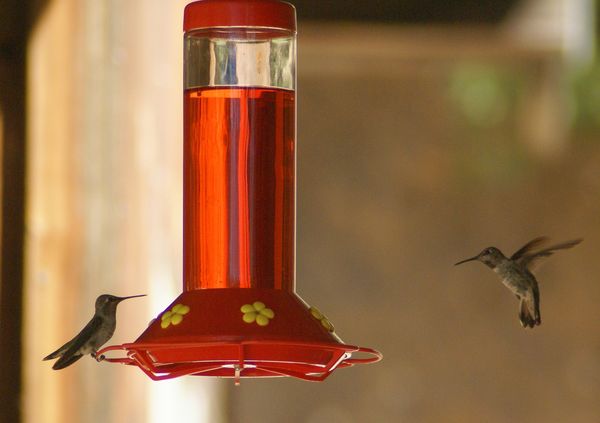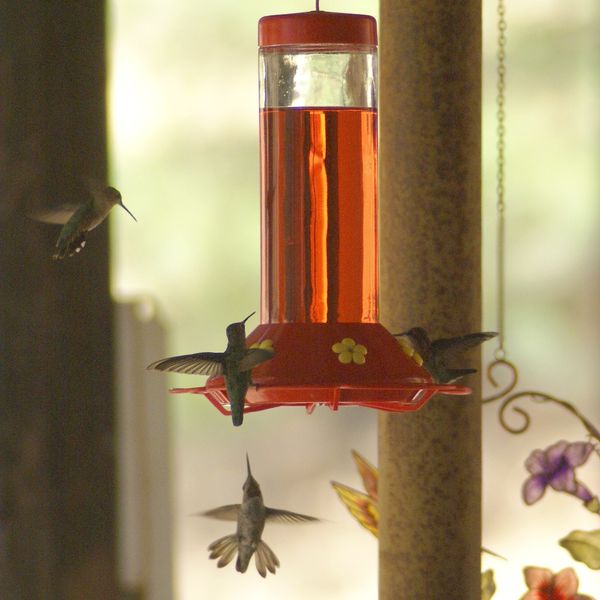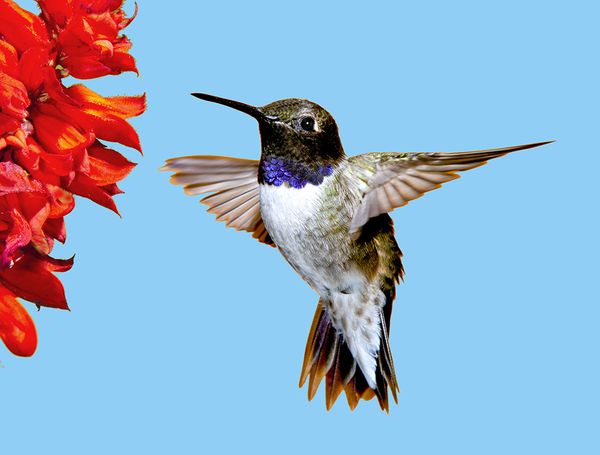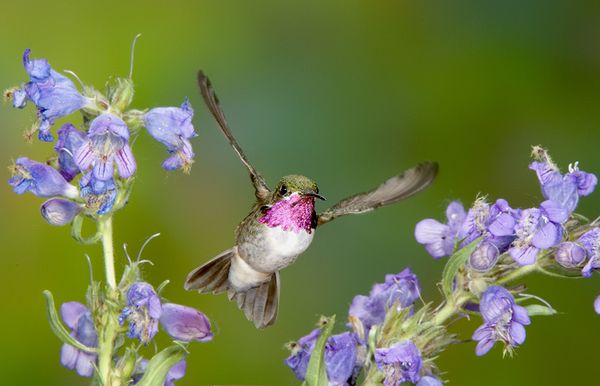High Speed Sync
Sep 11, 2011 15:13:53 #
I'd like to take some pictures of humming birds feeding at my backyard feeder. I assume I need a high shutter speed. I'd also like to stop the wing action by using a flash
I have a Canon 40D camera and a 580EX II flash. I've figured out how to put he flash in high speed sync (I believe...). What settings do I need on the camera? I've looked all through the book to no avail.
Anyone have any suggestions for me, please?
I have a Canon 40D camera and a 580EX II flash. I've figured out how to put he flash in high speed sync (I believe...). What settings do I need on the camera? I've looked all through the book to no avail.
Anyone have any suggestions for me, please?
Sep 11, 2011 20:47:35 #
High speed sync would probably be counter productive, unless you actually need flash for illumination.
With HSS, flash fires a bunch of times while the shutter curtains are moving. We still see it as one flash, but there are actually lots of mini-flashed being emitted. So you won't be freezing the action to any lesser time than the shutter speed set on your camera's body.
So if shooting with 1/8000 (or whatever your body allows) is enough, then you can use HSS flash, but it would only help make things brigher -- basically what the flash is for.
If you want to freeze the action with the use of flash to something a lot shorter than what your body allows, then you need to set it to regular mode (so it only fires once) and set the shutter speed to your highest sync rate, which is probably around 1/250.
After that, disable flash, lower the ISO and aperture to the point of everything being dark when flash is not fired. Once you enable the flash back on, you would effectively be taking exposure of "shutter speed" of around 1/20000 or even less, depending on the power output you set for the flash.
So for the settings, I would say, f/11 (or even lower, probably not enough in bright day light), ISO 100, and, well, shutter speed of 1/250.
Leave flash in regular mode and use ETTL.
If you notice that you are still not freezing the action (and if the image is still bright enough) then dial down flash exposure compensation by one stop. That would effectively halve the duration of the flash pulse, while also halving the amount of photons it emits. So it's a trade-off.
With HSS, flash fires a bunch of times while the shutter curtains are moving. We still see it as one flash, but there are actually lots of mini-flashed being emitted. So you won't be freezing the action to any lesser time than the shutter speed set on your camera's body.
So if shooting with 1/8000 (or whatever your body allows) is enough, then you can use HSS flash, but it would only help make things brigher -- basically what the flash is for.
If you want to freeze the action with the use of flash to something a lot shorter than what your body allows, then you need to set it to regular mode (so it only fires once) and set the shutter speed to your highest sync rate, which is probably around 1/250.
After that, disable flash, lower the ISO and aperture to the point of everything being dark when flash is not fired. Once you enable the flash back on, you would effectively be taking exposure of "shutter speed" of around 1/20000 or even less, depending on the power output you set for the flash.
So for the settings, I would say, f/11 (or even lower, probably not enough in bright day light), ISO 100, and, well, shutter speed of 1/250.
Leave flash in regular mode and use ETTL.
If you notice that you are still not freezing the action (and if the image is still bright enough) then dial down flash exposure compensation by one stop. That would effectively halve the duration of the flash pulse, while also halving the amount of photons it emits. So it's a trade-off.
Sep 12, 2011 10:39:18 #
Alan Nelson
Loc: Montana
Look up (google) The Art of Photographing Hummingbirds by John & Barbara Gerlach. Purchase their booklet on the subject and all of your questions will be answered.
Sep 12, 2011 10:45:57 #
If you've got moderate light (not bright sun) put the flash on a stand close to the feeder, and manually set your flash length. Fire the flash remotely using your on camera flash or a sync. Your shutter speed can be relatively slow because you're relying on the flash to stop the action, but I'd say open up your depth of field to keep the shutter speed close to the 250 mark. I think that's the max for flash sync, but I'd have to look it up. The booklet sounds like a great idea. i have a busy feeder twenty feet from my kitchen window, but I've never tried to capture any images.
Sep 12, 2011 10:51:29 #
No humming birds around here, but for similar situations I use a procedure similar to KG's. First, I select the highest shutter speed I can flash-synch at and choose a low ISO. The purpose here is to kill the ambient light so the exposure is totally reliant on flash. A slow shutter speed defeats the purpose of the flash. Second, I set the flash unit(s) as close as I reasonably can to the subject area. Third, if the flash is a dedicated TTL unit like your 580, I set it to Manual Mode; and adjust flash power to the lowest output, which yields the shortest exposure time. Now I set the lens aperture for about f8-f11 for max sharpness. Finally, I shoot test shots and adjust my flash-subject distance or ISO as required to get a good exposure. Try not to mess with the other settings or you lengthen the exposure time or loose sharpness. Now wait for the birdie!
It might seem to be a drawn out affair, but do it once or twice and you can set up in a couple minutes. Needless to say, off-camera flash works best. This will work well with any flash.
It might seem to be a drawn out affair, but do it once or twice and you can set up in a couple minutes. Needless to say, off-camera flash works best. This will work well with any flash.
Sep 12, 2011 14:49:56 #
I have a couple of Hummingbird photos that I have taken . I use 500 or 600 and 5.6 apature @ 1.500sec without flash and has given me some decent resulkts.
I have tried flash, but they scare the birds away for awhile. I hope this helps :-)
May God Bless
I have tried flash, but they scare the birds away for awhile. I hope this helps :-)
May God Bless
Sony A100DSLR 5.6 @1/500sec Iso500 300mm lense

Sony A100DSLR 300mm lense 1/500sec ISO 500 @ f 5/6

Sep 12, 2011 22:40:22 #
hobbycam -
Thanks for the info. I'll have to play around.
My, you have a very busy feeder. Aren't they fun to watch - the bird version of a helicopter.
Thanks for the info. I'll have to play around.
My, you have a very busy feeder. Aren't they fun to watch - the bird version of a helicopter.
Sep 12, 2011 22:44:02 #
Thanks everyone for the in-depth information. I believe that it will be very helpful. I really need to study it for a while and then do plenty experimenting.
It is late in the year, so I don't think I have too much time before they migrate for the winter. And, if not, at least I'll be prepared for next summer.
It is late in the year, so I don't think I have too much time before they migrate for the winter. And, if not, at least I'll be prepared for next summer.
Sep 12, 2011 23:08:20 #
Alan Nelson
Loc: Montana
If you do every thing right you could get some thing like I took early this summer.

Sep 13, 2011 01:05:15 #
Sep 13, 2011 01:54:57 #
Sep 13, 2011 13:45:54 #
Alan Nelson
Loc: Montana
As has been stated before the shutter speed has nothing to do with it. Set your flashes to manual then take the power down to about 1/32 so you have a very short flash duration about 1/18000. Your flashes have to be in quite close to the bird (15 "). I use no less than three and some times six flashes all synced to the same setting. Set shutter speed to flash sync such as 1/250 and be sure to shoot in a shaded area so no ambient light strikes the subject. The flash duration and not the shutter speed is what controls the lighting of the bird. Take an out of focus picture of green back ground and make it into a print so you have a background that keeps your attention on the bird. Two front flashes and one on the background is a minimum number of flashes one should use and up to six can be used. All flashes should fire at the same time and in sync with each other. Further help can be found on the internet.

Sep 13, 2011 19:02:48 #
Alan Nelson wrote:
If you do every thing right you could get some thing like I took early this summer.
They do love those red flowers, don't they!
Sep 15, 2011 00:47:36 #
Sep 15, 2011 01:13:55 #
Pilgrim wrote:
Boy, they sure do love red!
I grow fuschia in various colors of red, red/purple and violet and they do love them.
Once when I was sitting on a beach by a lake in Maine while wearing a hot pink bathing suit, a hummingbird came and landed on me ... I guess it thought I was a flower :-) I WAS younger then.
If you want to reply, then register here. Registration is free and your account is created instantly, so you can post right away.



